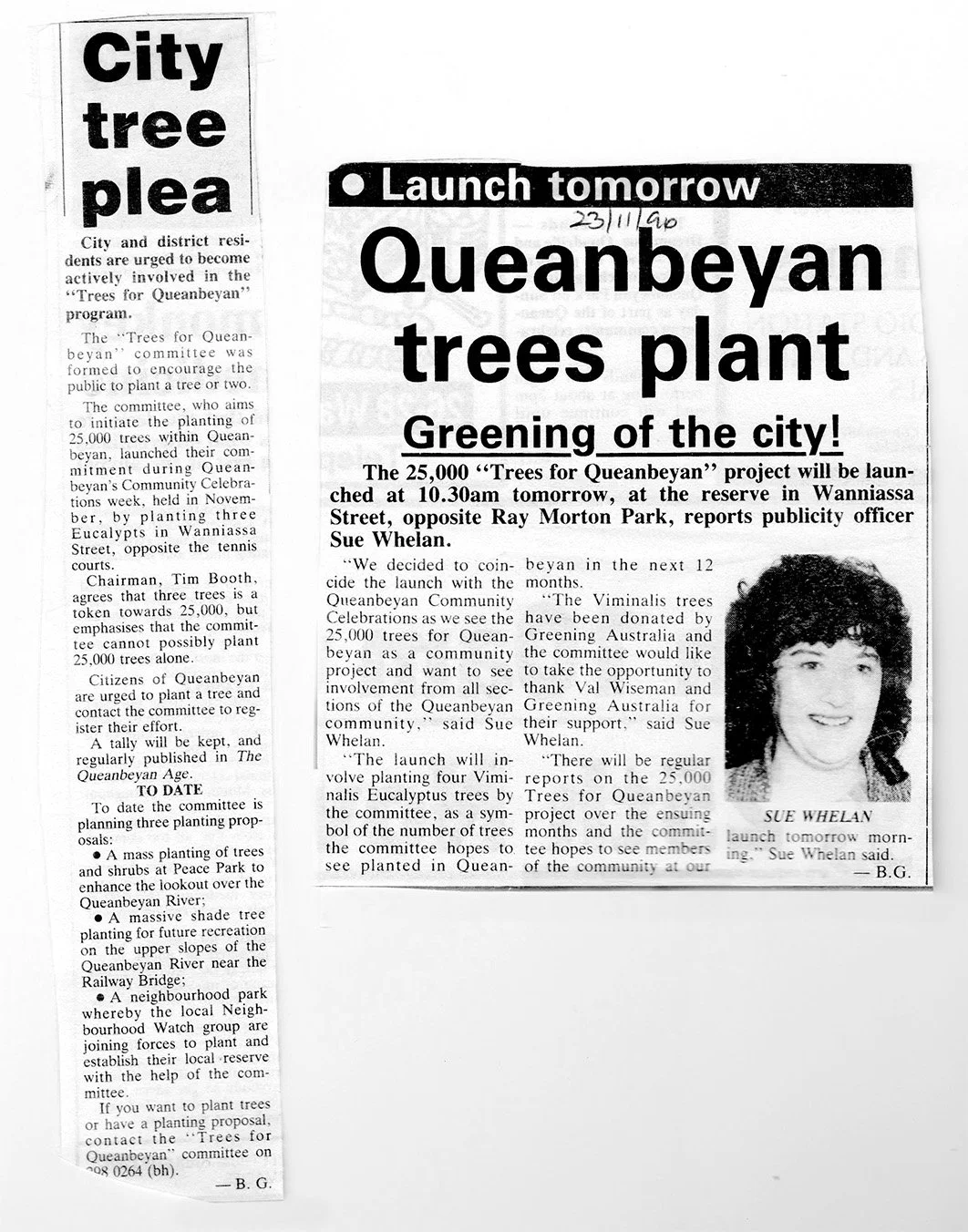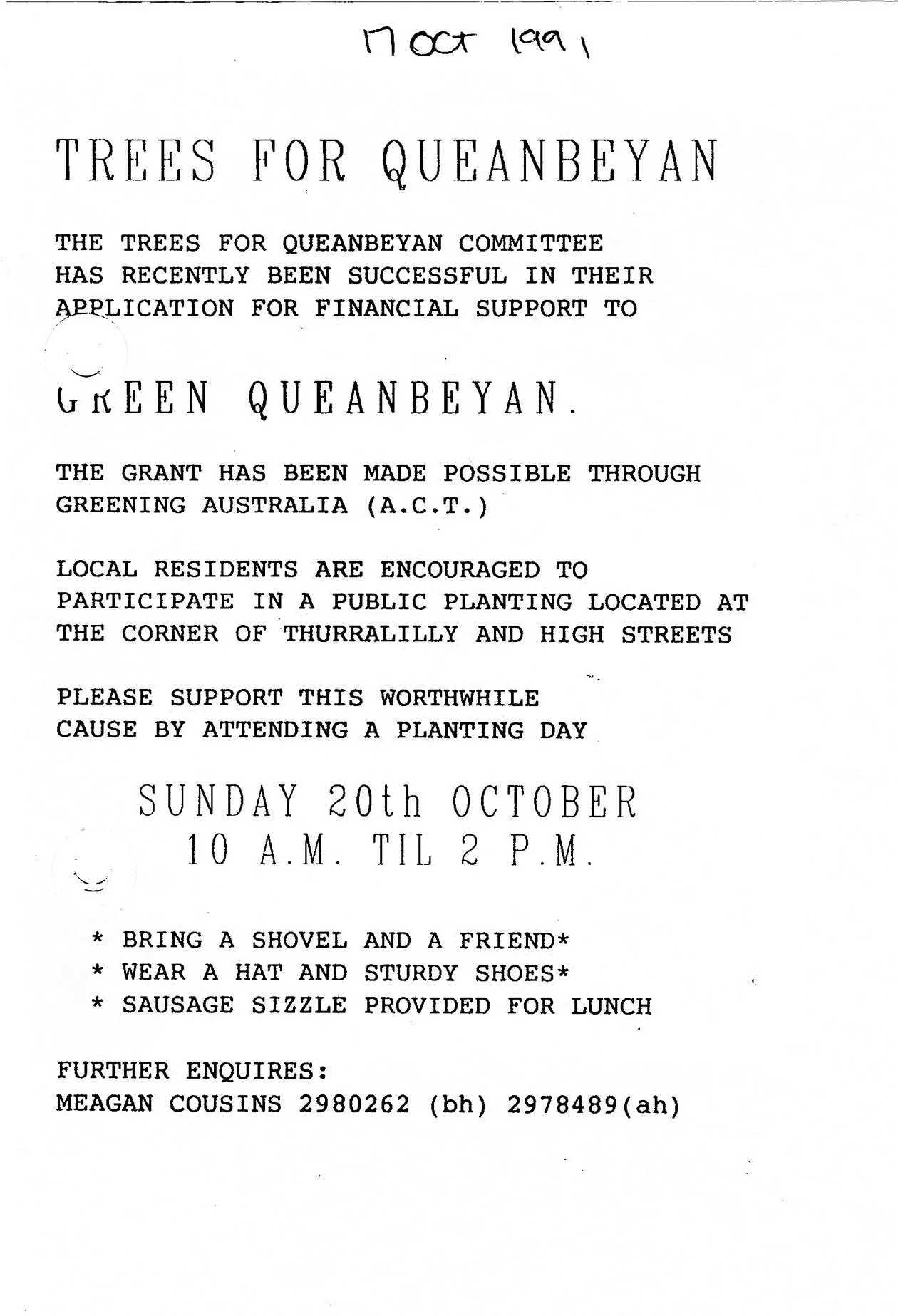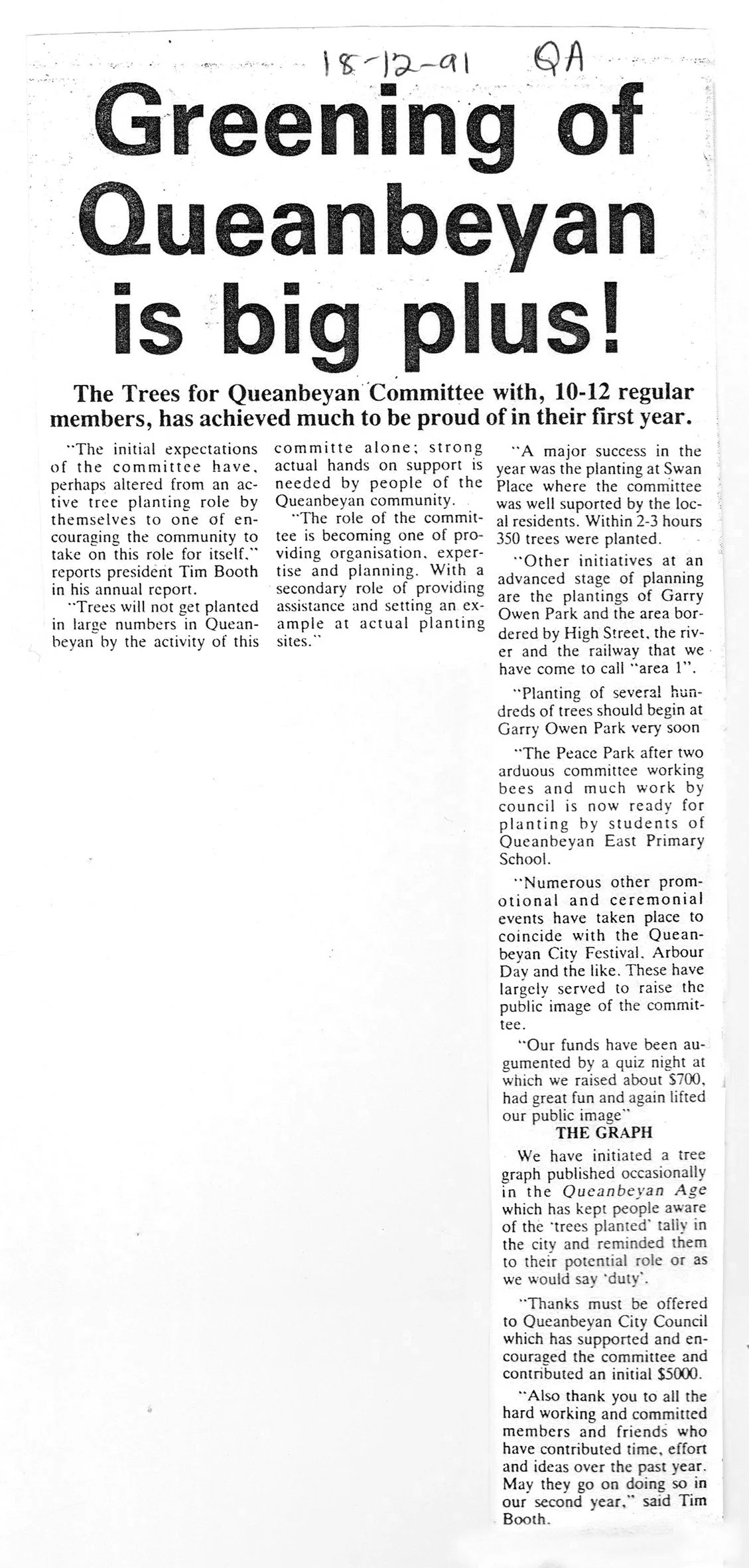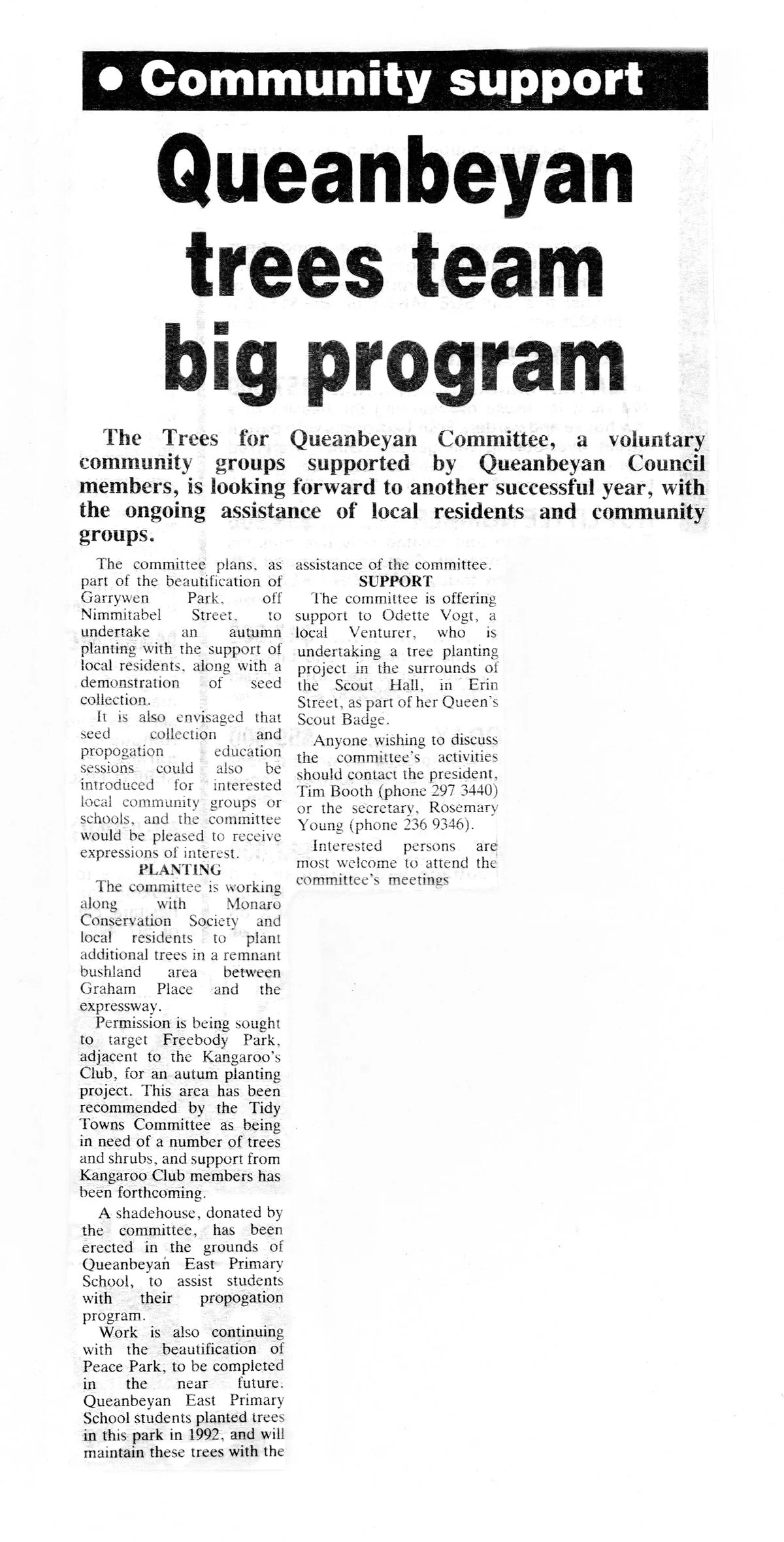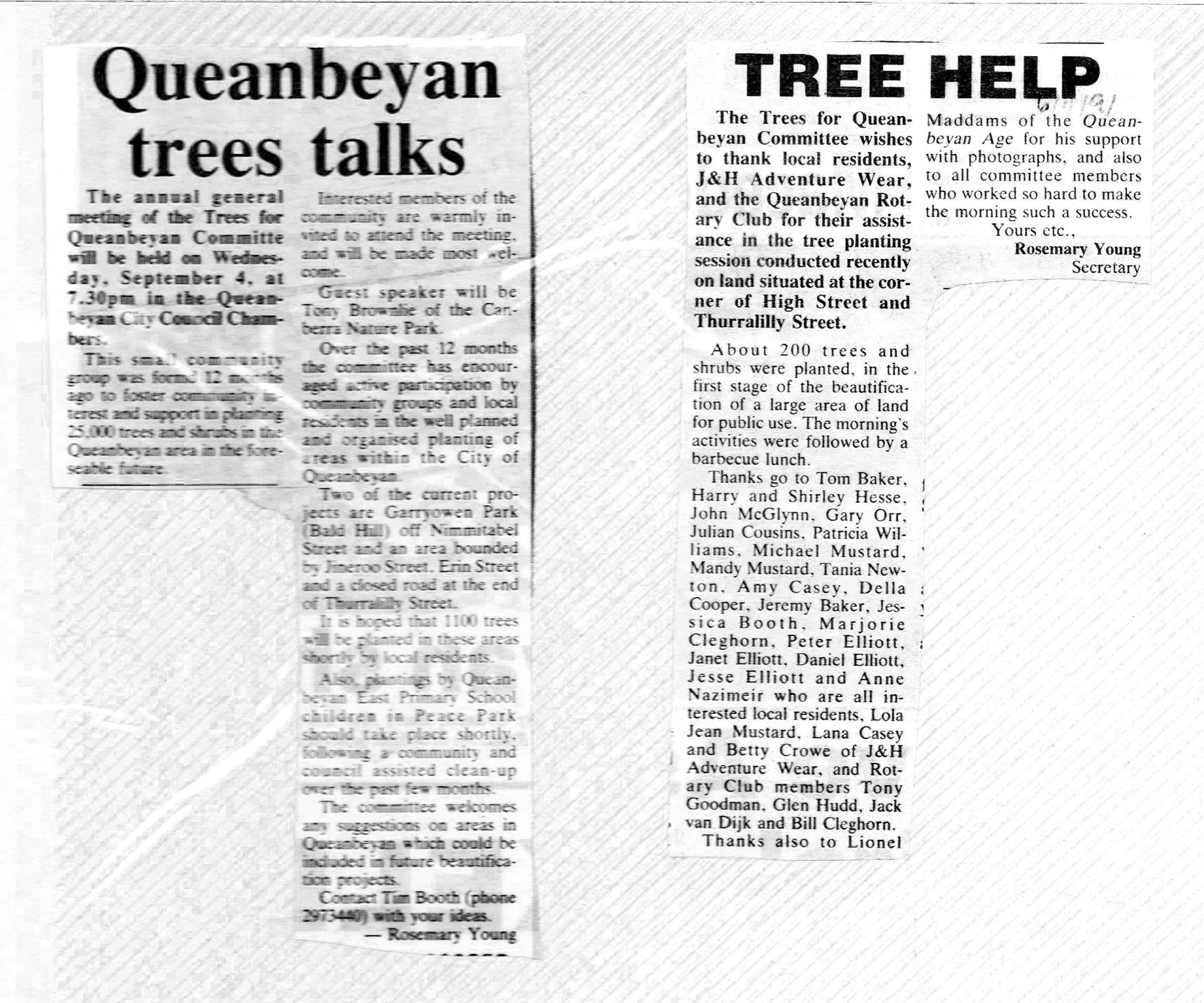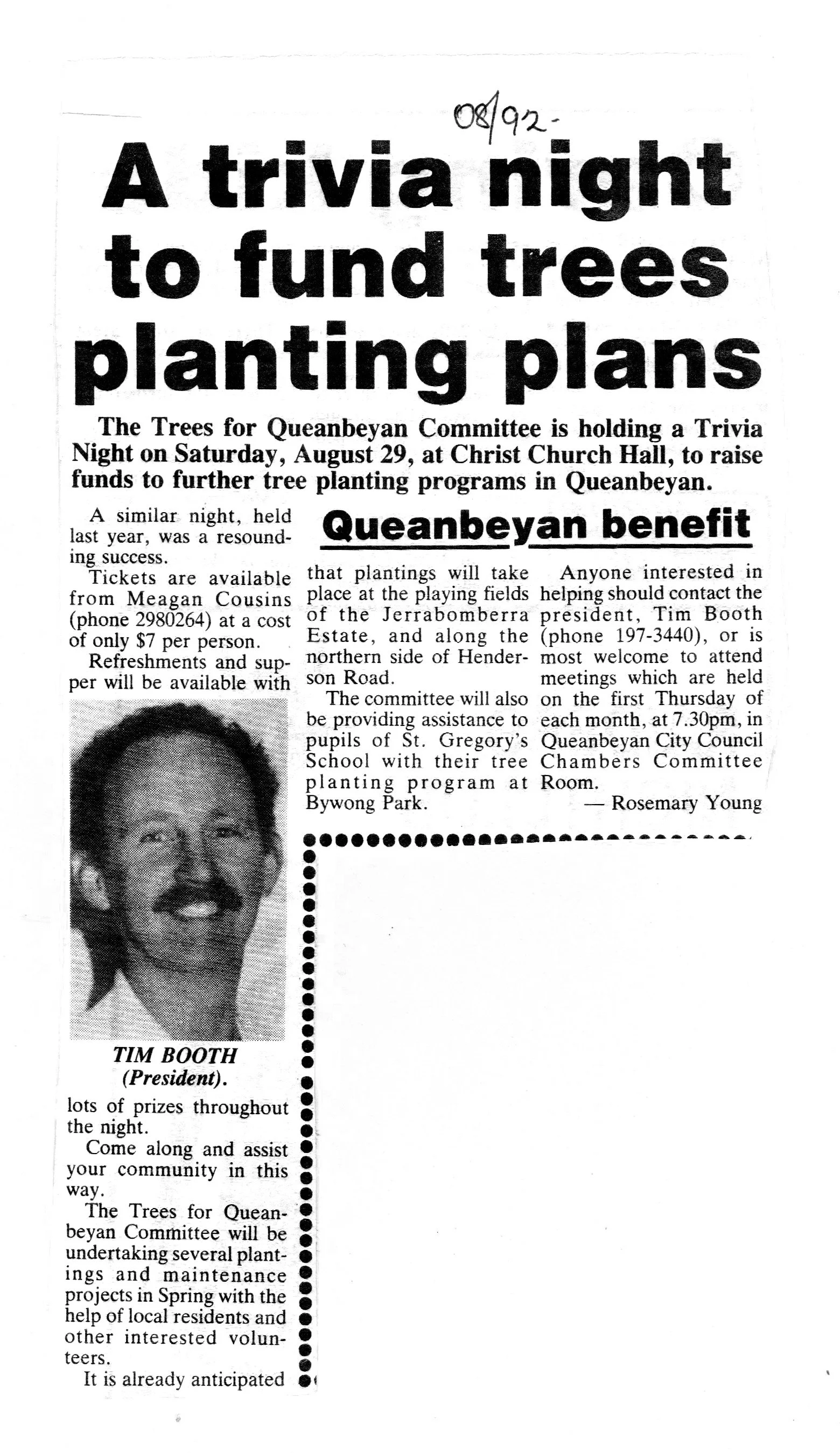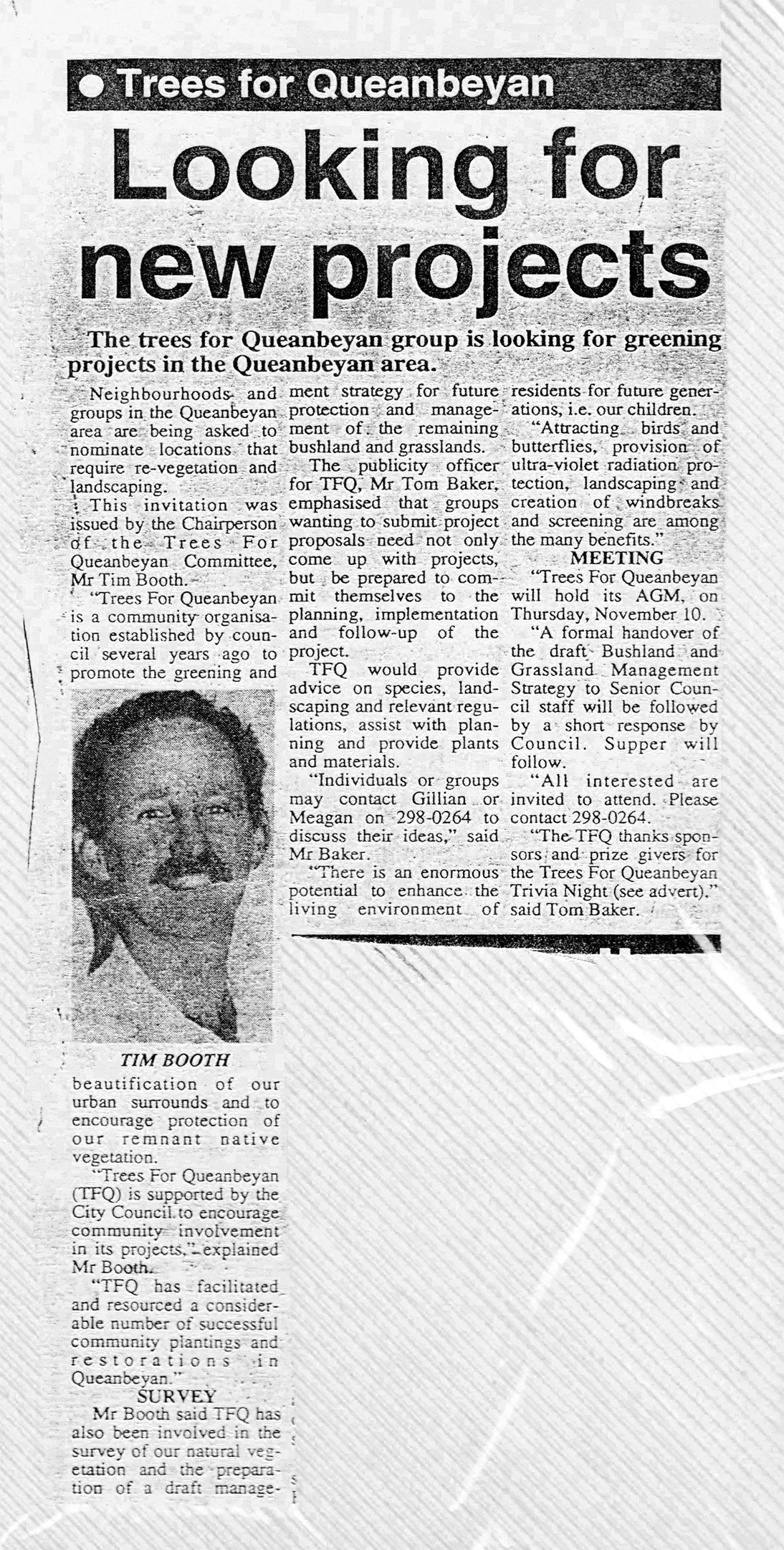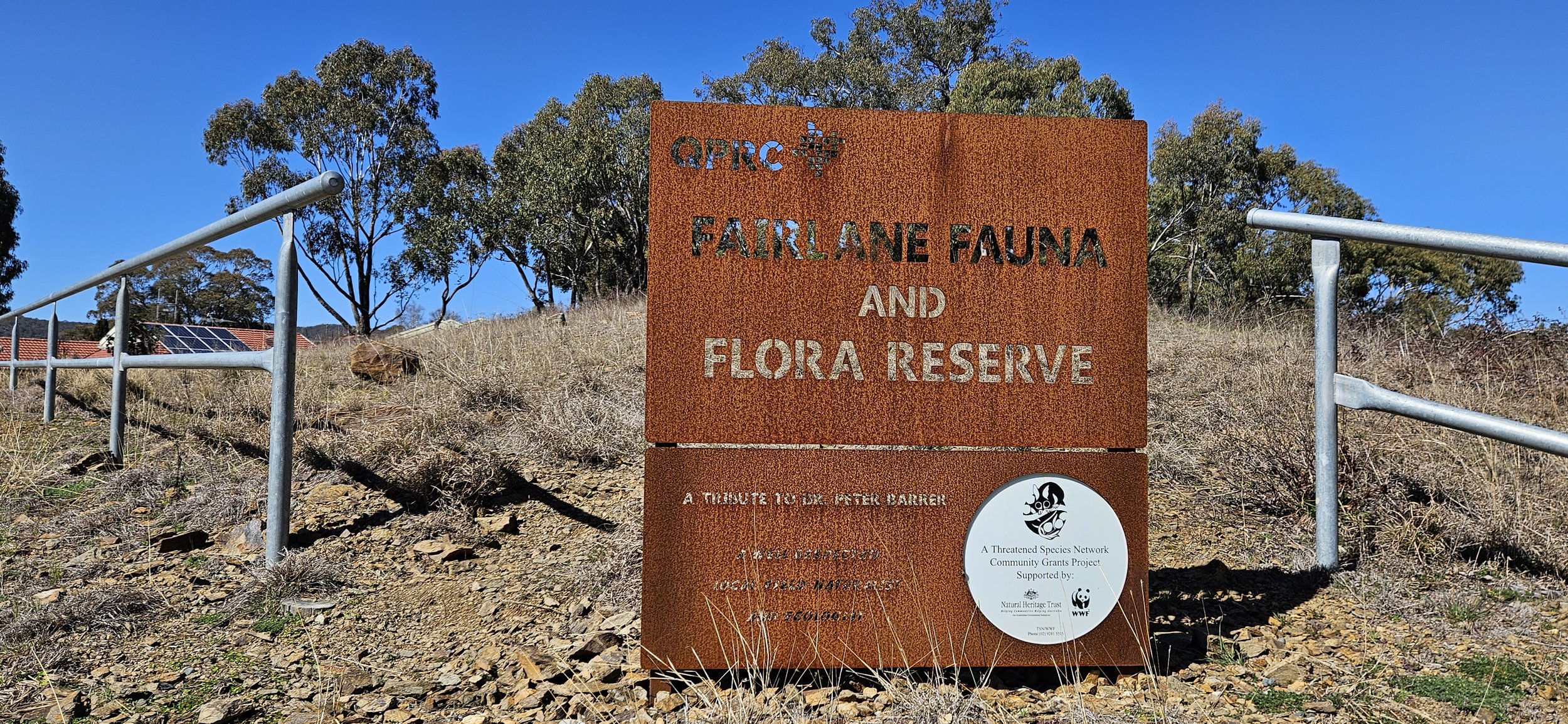
History Project Stories
TREES FOR QUEANBEYAN & MONARO CONSERVATION SOCIETY
Trees for Queanbeyan
Trees for Queanbeyan was established and supported by Queanbeyan Council in 1990 with a modest annual grant allocated to support the Committee. The first public meeting group was held on 22 August 1990.
Community members worked with the assistance of staff from Council’s Parks and Gardens Department. There were about 10 or 12 regular members. The main people were Allan Moss*, Tim Booth, Tom Baker, Meagan Cousins*, Gillian Pratten*, Ted Young, Rosemary Young, Louise Richards, Nance Tuckett, Derek Rutherford, Peter and Rosemary Gentry (* indicates members who were Council staff). A few of the active members were also members of Queanbeyan Rotary which later established their own plant nursery to benefit the Queanbeyan community.
The emphasis on Trees for Queanbeyan was on rehabilitating urban bushland sites and establishing neighbourhood plantings. The aim was to promote the greening and beautification of urban surrounds and to encourage protection of Queanbeyan’s remnant native vegetation. Benefits identified included attracting birds and butterflies, screening and shading, cooling.
Trees for Queanbeyan facilitated and resourced about 20 successful community plantings and restorations in Queanbeyan. Many of the stories of these plantings can be found at West Queanbeyan - Remnant Bushland and include:
River Drive
George Forbes House, Arthur Lambert Wing
Stockyard Creek Park, Acacia Drive playgrounds, Jerrabomberra Park
Jerrabomberra Estate at the large roundabout
North side of Henderson Road
Wickerslack and Tempe Crescent
Queanbeyan East Primary School
Winchester Place
Isabella Street Primary School
Swan Place in Fairlane Estate
Garryowen Park and surrounds
Peace Park
Corner Thurralilly and High Streets (in the High Street Dog Park, along the fence separating the industrial zone, Jineroo Street).
Erin Street
Bywong Park, upstream
Namai Place
Freebody Oval
Trees for Queanbeyan encouraged small local groups to identify projects and commit to the planning, implementation and follow-up. As a result, several smaller community groups emerged, for example the Wickerslack and Tempe Cresent Community Association.
Trees for Queanbeyan provided advice on species, landscaping, relevant regulations and assisted with planning and provided plants and materials. It raised funds for tree planting projects through Trivia Nights where local businesses and people donated prizes. It was also involved with seed collection, propagation and sales and education, erecting a shade house at Queanbeyan East Public School to assist students with their propagation. There was also a Schools Bush Garden project and a scheme whereby free native trees or shrubs were to be given away to the first 50 business houses in Queanbeyan industrial areas who indicated their acceptance. It was at this time that Tim Booth had a regular section in the local paper.
DR PETER BARRER (1942-1997)
On 2 Dec 1992 newspaper reported that Trees for Queanbeyan, Monaro Conservation Society and Queanbeyan council received a grant to employ Dr Peter Barrer as project officer to conduct a survey of remnant bushland areas within the city.
The funding for the work was from a grant of $18,000 from the National Landcare Program. Members from all groups worked on the grant application.
The survey results were to guide management decisions by Queanbeyan City Council in the day-to-day management of the 2200 hectares of bush within the city’s perimeter and promote the conservation of the remnant native vegetation.
Peter’s report is currently held in Box 3 of the resources held for Queanbeyan Landcare in the Frank Pangallo Heritage Library (see below) or is available on the web from the NSW State Library.
Peter Barrer was also employed by Queanbeyan Council from time to time to provide advice on the management of the ecological resources of the then Queanbeyan Local Government Area.
A further grant was obtained under the Save the Bush Grants Scheme, to employ Peter Barrer (Biosurveys) to produce the report, ‘The Flora of South-East Yarrowlumla, a Preliminary Assessment’. This project was supervised by the Monaro Conservation Society and the Stoney Creek Landcare Group. Importantly, this survey took in a number of crown land reserves, some very large. Peter passed away suddenly in May 1997, and the report was finalised and maps compiled by Nicki Taws. Supervision and assistance with compilation and editing was provided by Lynton Bond, Tim Booth and Tom Baker of the then Stoney Creek Landcare Group. The Stoney Creek Landcare Group didn’t survive; it was a sub-Committee of the Carwoola Residents Association.
During the surveys various landholders were involved in enabling access to private property and a number of people were involved in roadside surveys and animal scat hunts. These included Stephen Panter, Anne Clifton, Lybbie Hillman, Jane and Jim Cottee, Tim Booth, Deirdre and Alex Smith, Tom Baker, Les Manning, Lynton Bond, Sheryl Greathead, Leonie Schruer and Peter Quinlan.
These reports below are held in the Frank Pangallo Heritage Library for Queanbeyan Landcare.
This report was subsequently forwarded by the Stoney Creek Landcare Group to the South East NSW Regional Forest Agreement Process. Out of this process, the medium and very large areas of Crown Land encompassed by his work were gazetted as Nature Reserves or National Parks in 2001. These include Cuumbeun Nature Reserve North and South, Stoney Creek Nature Reserve, Wanna Wanna Nature Reserve, Yanununbeyan National Park, Yanununbeyan Nature Reserve and Yanununbeyan State Conservation Area.
Dr Peter Barrer’s contributions to conservation have been commemorated with the naming of the Fairlane Fauna Reserve in River Drive, Karabar, Queanbeyan. This reserve contains a healthy population of the threatened pink tailed legless lizard, detected by Peter. The Reserve continues to be surveyed bi-annually by members of Queanbeyan Landcare and community members. Dr Barrer’s work in the Lower Molonglo in the ACT has also been recognized in the naming of Barrer Hill.
Dr Barrow inherited a large sum of money from his parents in England and in his will, he bequeathed money to conservation. Ultimately over $0.5million was directed towards the purchase of Scottsdale, a 3,000-acre property 4 kilometers north of Bredbo straddling the Murrumbidgee River, by Bush Heritage Australia for management as part of their network of biodiversity reserves across Australia.
A management strategy was prepared for the future protection and management of the remaining bushlands and grasslands in what was then the Queanbeyan LGA. Formal handover of the draft Bushland and Grassland Management Strategy occurred on Thursday November 24 at the Kangaroos Club in 1994.
The series of documents comprising this Strategy was drafted by a senior Queanbeyan Council Planner, in close consultation with a Community Consultative Committee, including members of Monaro Conservation Society. The documentation was based on the report by Dr Peter Barrer cited above and available in the Frank Pangello Heritage Library, it included draft Management Plans for some key land lots.
Trees for Queanbeyan disbanded to form Queanbeyan Landcare Incorporated in 1995, Queanbeyan Landcare continued to use the TFQ post box at PO BOX 848 until 2025.
Queanbeyan Bushland and Grassland Management Strategy
ACT Commissioner for Sustainability and the Environment | Regional State of the Environment Report 2004-2009 | Queanbeyan - Indicator: Native Species
MONARO CONSERVATION SOCIETY
The Monaro Conservation Society formed in 1988 as an activist group focussed on opposing development on the slopes of Mt Jerrabomberra. For details see The Mount Jerrabomberra Story - History Project Stories — Queanbeyan Landcare.
The group was a member of the Conservation Council of the South-East Region and Canberra.
As well as seeking to protect Mount Jerrabomberra members worked with TFQ to plant additional trees in remnant bushland between Graham Place, Canberra Avenue and Lanyon Drive. See West Queanbeyan - Remnant Bushland — Queanbeyan Landcare . They were actively involved in protection of Gale Grassy Box Woodland, attended Council public meetings on Bicentennial Park and helped host the Planet Earth event held in Queanbeyan on 27 & 28 October 1989.
The main people involved were Bill Willis, Kerry Ruth, John McGlynn, Colin Webb, Tom Baker and Les Manning.
Monaro Conservation Society acted as "watchdog’ according to John McGlynn. (2022 interview)
You always had to be ready to make a comment or submission. We always watched the papers. (Kerrie Ruth, 2022).
Resources including the original newspaper clippings and the Minutes for this piece are located within the boxes stored for Queanbeyan Landcare in the Frank Pangallo Heritage Library. Sadly, many of the newspaper articles are undated but details have been confirmed by Tom Baker.






